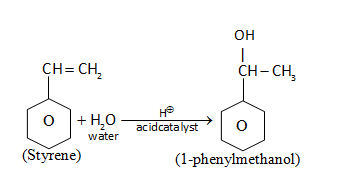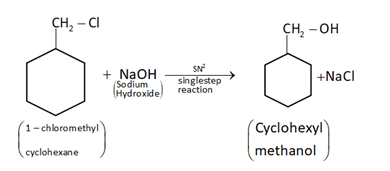
Show how you will synthesise:
(i) 1-Phenylethanol from a suitable alkene.
(ii) Cyclohexylmethanol using an alkyl halide by a \[S{N^2}\]reaction.
(iii) Pentan-1-ol using a suitable alkyl halide.
Answer
220.8k+ views
Hint: These reactions are either electrophilic addition or nucleophilic substitution reaction. In an electrophilic addition reaction, a $\pi $ bond is broken and two new $\sigma $ bonds are formed. In nucleophilic substitution reaction, a leaving group is replaced by an electron rich compound.
Complete step by step solution:
Synthesis of the following reaction:
(i) 1-phenylethanol from suitable alkene.
Alkene is treated with \[{H_2}O\]in the presence of acid (acid catalyzed hydrolysis) to give 1-phenylmethanol

(ii) Cyclohexylmethanol using an alkyl halide by a \[S{N^2}\] reaction.
When chloromethylcyclohexane is treated with sodium hydroxide, then it will give cyclohexylmethanol by \[S{N^2}\]mechanism.

(iii) Pentan-1-ol using a suitable alkyl halide.
When chloropentane is treated with aq.$NaOH$, then it will give pentan-1-ol.
\[\mathop {C{H_3}C{H_2}C{H_2}C{H_2}C{H_2}}\limits_{\left( {1 - Chloropen\tan e} \right)} - Cl + \mathop {aq.NaOH}\limits_{\left( \begin{subarray}{l}
Sodium \\
Hydroxide
\end{subarray} \right)} \xrightarrow{{}}\mathop {C{H_3}C{H_2}C{H_2}C{H_2}C{H_2} - OH + NaCl}\limits_{\left( {Pen\tan - 1 - ol} \right)} \]
Note: Alpha methylbenzyl alcohol appears as a colourless liquid which is insoluble in water and less dense than water. Cyclohexylmethanol is an organic compound and these reactions are bimolecular nucleophilic substitution reactions. 1 - Pentanol is a colourless liquid with a distinctive aroma. It is the straight- chain form of amyl alcohol and the hydroxyl group is the active site of many reactions. Electrophilic addition reactions are an important class of reaction that allow the inter conversion of $C = C$and $C \equiv C$ into a range of important functional groups including alkyl halides and alcohols. Addition reaction is the reverse of elimination reactions and in nucleophilic substitution reactions, the stronger nucleophile replaces a weaker nucleophile.
Complete step by step solution:
Synthesis of the following reaction:
(i) 1-phenylethanol from suitable alkene.
Alkene is treated with \[{H_2}O\]in the presence of acid (acid catalyzed hydrolysis) to give 1-phenylmethanol

(ii) Cyclohexylmethanol using an alkyl halide by a \[S{N^2}\] reaction.
When chloromethylcyclohexane is treated with sodium hydroxide, then it will give cyclohexylmethanol by \[S{N^2}\]mechanism.

(iii) Pentan-1-ol using a suitable alkyl halide.
When chloropentane is treated with aq.$NaOH$, then it will give pentan-1-ol.
\[\mathop {C{H_3}C{H_2}C{H_2}C{H_2}C{H_2}}\limits_{\left( {1 - Chloropen\tan e} \right)} - Cl + \mathop {aq.NaOH}\limits_{\left( \begin{subarray}{l}
Sodium \\
Hydroxide
\end{subarray} \right)} \xrightarrow{{}}\mathop {C{H_3}C{H_2}C{H_2}C{H_2}C{H_2} - OH + NaCl}\limits_{\left( {Pen\tan - 1 - ol} \right)} \]
Note: Alpha methylbenzyl alcohol appears as a colourless liquid which is insoluble in water and less dense than water. Cyclohexylmethanol is an organic compound and these reactions are bimolecular nucleophilic substitution reactions. 1 - Pentanol is a colourless liquid with a distinctive aroma. It is the straight- chain form of amyl alcohol and the hydroxyl group is the active site of many reactions. Electrophilic addition reactions are an important class of reaction that allow the inter conversion of $C = C$and $C \equiv C$ into a range of important functional groups including alkyl halides and alcohols. Addition reaction is the reverse of elimination reactions and in nucleophilic substitution reactions, the stronger nucleophile replaces a weaker nucleophile.
Recently Updated Pages
The hybridization and shape of NH2 ion are a sp2 and class 11 chemistry JEE_Main

What is the pH of 001 M solution of HCl a 1 b 10 c class 11 chemistry JEE_Main

Aromatization of nhexane gives A Benzene B Toluene class 11 chemistry JEE_Main

Show how you will synthesise i 1Phenylethanol from class 11 chemistry JEE_Main

The enolic form of acetone contains a 10sigma bonds class 11 chemistry JEE_Main

Which of the following Compounds does not exhibit tautomerism class 11 chemistry JEE_Main

Trending doubts
JEE Main 2026: Application Form Open, Exam Dates, Syllabus, Eligibility & Question Papers

Derivation of Equation of Trajectory Explained for Students

Hybridisation in Chemistry – Concept, Types & Applications

Understanding the Angle of Deviation in a Prism

How to Convert a Galvanometer into an Ammeter or Voltmeter

Degree of Dissociation: Meaning, Formula, Calculation & Uses

Other Pages
NCERT Solutions For Class 11 Chemistry Chapter 7 Redox Reaction

JEE Advanced Marks vs Ranks 2025: Understanding Category-wise Qualifying Marks and Previous Year Cut-offs

Hydrocarbons Class 11 Chemistry Chapter 9 CBSE Notes - 2025-26

Thermodynamics Class 11 Chemistry Chapter 5 CBSE Notes - 2025-26

NCERT Solutions ForClass 11 Chemistry Chapter Chapter 5 Thermodynamics

Equilibrium Class 11 Chemistry Chapter 6 CBSE Notes - 2025-26




